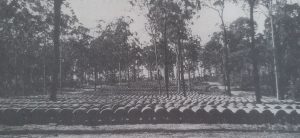Darra Ordnance Depot: role and significance

During World War II the Darra Ordnance Depot—situated along Archerfield Road—played a crucial role in the South West Pacific theatre. Constructed in early 1942, the site quickly became one of the largest munitions depots in the region, supporting the logistical needs of Allied forces and acting as a major supply node for operations across Australia’s northern and Pacific theatres.
Military operations and infrastructure
The depot was operated by US ordnance units. African-American soldiers of the 636th Ordnance Ammunition Company, serving under white officers, carried out much of the hands-on work of maintaining and distributing weapons, vehicles and equipment and of handling, storing, testing and disposing of munitions. Supporting units recorded at the site included the 577th Ordnance Ammunition Company, the 28th Chemical Company, the 48th Quartermaster Truck Regiment and the 5203rd Quartermaster Truck Battalion. Because of the hazardous nature of the stockpiles there were minimal permanent buildings on the ordnance ground—apart from a fire tower and a command post situated on the grounds of the former Archerfield Homestead (now part of Homestead Park).
Chemical weapons storage
Crucially, Darra was not only a conventional ammunition depot: it also stored large quantities of chemical warfare agents and related munitions. contemporary inventories show that by January 1943 the depot held very substantial chemical stocks, and by November 1943 the listed holdings included hundreds of tonnes of bulk agents and thousands of chemical shells and other items. Reported holdings from period records and post-war inventories include large quantities of mustard gas, lewisite, tear-gas solution (CNS), gas artillery shells, DM (toxic smoke) candles and a number of empty bomb and shell casings associated with chemical programmes. These figures underline that Darra functioned as a major chemical-weapons storage and handling site for US forces in Australia.
(examples from contemporary inventories: November 1943 listings show on the order of hundreds of tonnes of bulk mustard and lewisite, tens of tonnes of tear-gas solution, several thousand chemical artillery shells and several thousand DM candles. These numbers are derived from wartime depot records and published inventories—see sources below for exact itemised lists.)
Access, transport and security
The depot’s main entrance faced Archerfield Road, with secondary gates at Progress Road (the Wacol gate) and Blunder Creek Road. Day and night transport runs connected the site to Wacol train station and to Brisbane wharves, reflecting its importance in regional supply chains. Security was extensive: civilian guards (some 70 men, including local recruits) patrolled the perimeter—often on horseback—and military policing kept strict control of access.
Life at the Depot and community relations
Personnel who worked the depot were housed in nearby Camp Darra and other accommodation camps in Richlands, Inala and Forest Lake. Camp facilities included wooden huts, bell tents, a parade ground and an open-air picture theatre; Saturday screenings and other entertainments brought soldiers and local residents into contact. These interactions produced a mix of goodwill and tension: while social events offered opportunities for community engagement, they also exposed local people to the racial segregation practised by parts of the US military and to reports of harsh discipline and occasional violent incidents that were rapidly contained by military authorities.
Hazards and legacy
The presence of chemical agents and large conventional munitions made Darra inherently dangerous. Accidents, unexploded ordnance and later explosions (and post-war sea-dumping of chemical munitions in Australian waters) have left a complex legacy of contamination and safety concerns. The depot’s history therefore raises both heritage questions about Brisbane’s central role in the Allied logistical network and environmental and public-safety questions that linger to the present. Researchers continue to investigate the quantities and fates of the chemical stocks once held at Darra and the subsequent disposal actions.
See also: OzatWar
Freak war dump blast
| Courier Mail Brisbane 24 January 1947 QUESTIONS about a Dutch dump of 300 tons of ammunition at Darra, which was the scene of a violent explosion yesterday, were answered last night by Dutch and R.A.A.F. officials. Yesterday’s explosion was a freak, and unlikely to occur again, and probably was caused by water mixing with chemicals in the ammunition, said the R.A.A.F. officer in charge of the dump. Dutch authorities to-day will investigate the explosion, which, occurred soon after 11.30 a.m. yesterday. A Dutch Army spokesman said last night that 300 tons of Dutch ammunition were stored at Darra. Of these. 180 tons had been marked for disposal. It had not been decided what was to be done with the remaining 120 tons, which was still usable. The Australian Army had undertaken to dispose of the useless ammunition. Quantity of ammunition lost in yesterday’s explosion was not known. The dump consisted chiefly of mortar bombs, hand grenades, and rifle and revolver cartridges. Two other dumps of about equal size, both of which were within 20 yards of the explosion, remained intact. Fireman’s Escape The explosion started a fire, flames from which rose 20 feet in the air. Firemen who were called were powerless to fight the blaze.A piece of shrapnel smashed the windscreen of the fire truck, which was parked more than 200 yards from the dump. A fireman who had been sitting where the shrapnel struck had just descended from the wagon and was lucky to escape serious injury. Rain prevented the flames, from spreading through the surrounding bush, and the fire burned itself out within two hours. Flying-Officer Dutton, the R.A.A.F. officer in charge of the dump, said that Dutch ammunition was stored at Darra because there was no other dump available round Brisbane. He had made repeated efforts to get the Dutch to remove the ammunition, because plans had been made for closing the dump. No Dutch ammunition had been taken away, but some had been brought in since he took over command of the camp about nine months ago. The Darra unit was known as a replenishment centre. It supplied ammunition to the R.A.A.F. for training, and also served as a store. Source: Trove – National Archives of Australia |
Eye witness account: Explosion at Dutch ammo depot
| “Next grenades started to explode followed by small arms ammunition.Shrapnel was flying everywhere ruining the roof of a nearby house and smashing the windscreens from the approaching fire brigade vehicles. They obviously didn’t enter the site. The carnage went on for 4 hours and fortunately the nearby stockpile of 250lb bombs didn’t go off.“Eyewitness account from Keith Brough published in the book World War II stories from Brisbane’s South West by Vicki Mynott. |
The cause was indeed that after a heavy storm, rainwater had seeped through the tarpaulins covering mortar bombs, the water reached a Seamarker flare and made it to go off. These markers alert rescuers for pilots who crash in water After the war the RAAF cleaned up any remaining dangerous ammunition.
